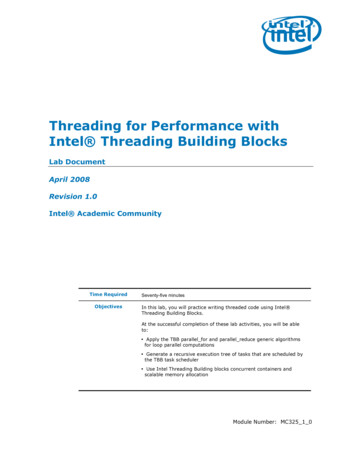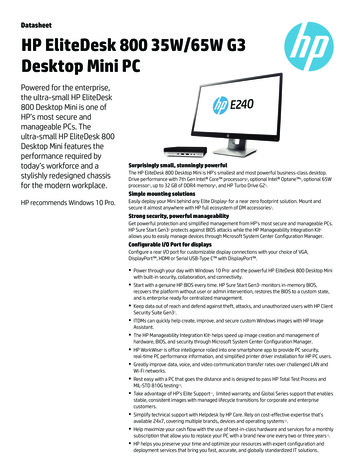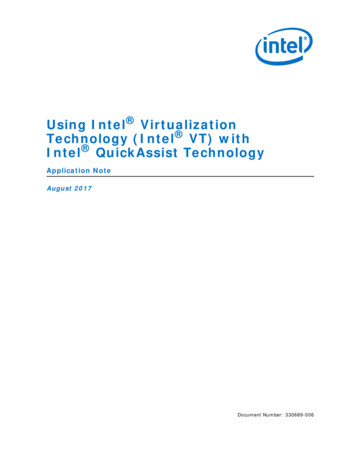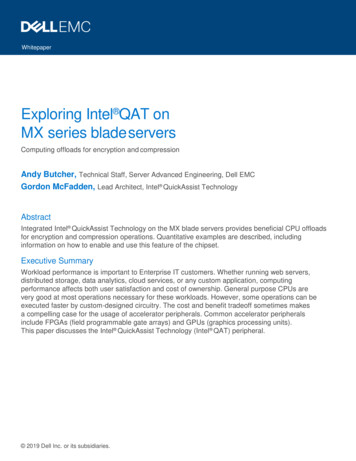
Transcription
Threading for Performance withIntel Threading Building BlocksLab DocumentApril 2008Revision 1.0Intel Academic CommunityTime RequiredObjectivesSeventy-five minutesIn this lab, you will practice writing threaded code using Intel Threading Building Blocks.At the successful completion of these lab activities, you will be ableto: Apply the TBB parallel for and parallel reduce generic algorithmsfor loop parallel computations Generate a recursive execution tree of tasks that are scheduled bythe TBB task scheduler Use Intel Threading Building blocks concurrent containers andscalable memory allocationModule Number: MC325 1 0
Intel Academic CommunityINFORMATION IN THIS DOCUMENT IS PROVIDED IN CONNECTION WITH INTEL PRODUCTS. NO LICENSE, EXPRESS ORIMPLIED, BY ESTOPPEL OR OTHERWISE, TO ANY INTELLECTUAL PROPERTY RIGHTS IS GRANTED BY THIS DOCUMENT. EXCEPTAS PROVIDED IN INTEL’S TERMS AND CONDITIONS OF SALE FOR SUCH PRODUCTS, INTEL ASSUMES NO LIABILITYWHATSOEVER, AND INTEL DISCLAIMS ANY EXPRESS OR IMPLIED WARRANTY, RELATING TO SALE AND/OR USE OF INTELPRODUCTS INCLUDING LIABILITY OR WARRANTIES RELATING TO FITNESS FOR A PARTICULAR PURPOSE, MERCHANTABILITY,OR INFRINGEMENT OF ANY PATENT, COPYRIGHT OR OTHER INTELLECTUAL PROPERTY RIGHT. Intel products are not intended foruse in medical, life saving, or life sustaining applications.Intel may make changes to specifications and product descriptions at any time, without notice.Designers must not rely on the absence or characteristics of any features or instructions marked "reserved" or "undefined." Intelreserves these for future definition and shall have no responsibility whatsoever for conflicts or incompatibilities arising from futurechanges to them.Intel and the Intel logo are trademarks or registered trademarks of Intel Corporation or its subsidiaries in the United States andother countries.*Other names and brands may be claimed as the property of others.Copyright 2008, Intel Corporation. All rights reserved.2 April 2008 Intel Corporation
Threading for Performance with Intel Threading Building BlocksContentsActivity 1:Using parallel for . 5Build and Run Serial Program . 5Modify Serial Program to use Intel TBB parallel for . 5Activity 2:Using parallel reduce. 6Build and Run Serial Program . 6Modify Serial Program to use Intel TBB parallel reduce . 6Activity 3:Generating Recursive Tasks. 8Modify, Build, and Run Threaded Program . 8Activity 4:Using the concurrent hash map Container .10Modify, Build, and Run Threaded Application.10Activity 5:Using Scalable Memory Allocators .12Build and Run Serial Program .12Modify Program to use Intel TBB scalable allocator .12 April 2008 Intel Corporation3
Intel Academic CommunityRevision HistoryDocumentNumberRevisionNumberMC325 1 01.0DescriptionInitial release.Revision DateApril 2008Note: On Windows platforms, if you experience link errors, try switching the configurationbetween “win32” and “x64” and relinking. Depending on the library available on yoursystem, there may be compatibility issues that could be cleared up by matching thelibrary version to the compiled code§4 April 2008 Intel Corporation
Threading for Performance with Intel Threading Building BlocksActivity 1: Using parallel forTime RequiredObjectiveFifteen minutesModify a serial matrix multiplication code to do computations inparallel through the Intel TBB parallel for generic algorithm.The application generates two NxN matrices and then does a matrix multiplication onthese two matrices. The code contains two separate matrix multiplication calls: one inserial and one in parallel (though the parallel version initially calls the serial function).The two calls are timed in order to see if the parallel version (when run on a multicore processor) will run in less time than the serial version.Build and Run Serial Program1.Locate and change to the 01 Matrix Multiply directory. You should find VisualStudio Solution and project files and a source file, mxm serial.cpp, in thisdirectory.2.Double-click on the solution icon and examine the source file.3.Be sure the Release configuration is selected and build the executable binary.4.After successfully compiling and linking, run the executable.This can be done from the Visual Studio IDE by selecting the “Start withoutDebugging” command (CTRL F5). The output reports a serial and a paralleltime, that should be close to each other, and a computed speed up of the parallelover the serial time.Modify Serial Program to use Intel TBBparallel for1.2.Modify the ParallelMxM function to perform the matrix multiplication in parallelusing Intel TBBa.Create a Body class and define the operator() to perform multiplicationsacross a range of index values. At what loop level should the parallelismbe implemented?b.Replace original body of the ParallelMxM function with an execution(s) ofparallel for using your defined Body class and the TBB definedblocked range.Compile and debug the application. Once you have a clean compilation, run theparallel executable.What was the speedup of the parallel version? April 2008 Intel Corporation5
Intel Academic CommunityActivity 2: Using parallel reduceTime RequiredObjectiveTwenty minutesModify a numerical integration code to do computations in parallel andcollect a computed reduction through the Intel TBB parallel reducegeneric algorithm.The application computes an approximation of pi (3.1415926 ) through numericalintegration using the midpoint rectangle rule. Thus, for a given number of stepsbetween 0.0 and 1.0, the function f(x) 4.0 / (1 x*x) is evaluated, whichcorresponds to the height of the rectangles. The sum of all the rectangle heights iscomputed and this is multiplied by the inverse of the number of steps (width ofrectangles) to compute pi.The computation is timed in order to see if the parallel version (when run on a multicore processor) will run in less time than the serial version.Build and Run Serial Program1.Locate and change to the 02 Numerical Integration directory. You should findVisual Studio Solution and project files and a source file, pi.cpp, in this directory.2.Double-click on the solution icon and examine the source file.3.Be sure the Release configuration is selected and build the executable binary.4.After successfully compiling and linking, run the executable. This can be donefrom the Visual Studio IDE by selecting the “Start without Debugging” command(CTRL F5).What is the serial time of the application?Modify Serial Program to use Intel TBBparallel reduce1.Modify the application to perform the repeated computations of the function beingintegrated in parallel using Intel TBB. Each task created will compute a separate,local copy of the sum of rectangle heights that need to be gathered and summed(reduced) in to the final global sum.a.6Create a Body class and define the operator() to perform functioncomputations across a range of index values. You will also need to definea split (to initialize the local sum) and a join method (to combine twolocal sum values) in order to use the parallel reduce. April 2008 Intel Corporation
Threading for Performance with Intel Threading Building Blocksb.2.Replace original body of the for-loop computations with a call toparallel reduce using your defined Body class and the TBB definedblocked range.Compile and debug the application. Once you have a clean compilation, run theparallel executable.What is the execution time of the parallel version?What was the speedup of the parallel version? April 2008 Intel Corporation7
Intel Academic CommunityActivity 3: Generating Recursive TasksTime RequiredObjectiveFifteen minutesModify a partially parallelized binary tree traversal application. Thetraversal is done in parallel by creating recursive of TBB tasks for eachbranch of the tree.Modify, Build, and Run Threaded Program1.Locate and change to the 03 recursive tasks directory.a.The original.h file contains the SerialTreeTraversal function, whichimplements serial tree traversal. The nodes of the tree can be processedindependently. The task scheduler interface that Intel(R) ThreadingBuidling Blocks (Intel(R) TBB) provides naturally supports recursiveparallelism.b.The TODO.h contains an incomplete an implementation of theMyRecursiveTask::execute method. The goal of this exercise is to learnthe basic elements of the task scheduler interface and complete theimplementation of MyRecursiveTask::execute method.2.Review the serial implementation of the recursive tree traversal algorithm(original.h).3.Open TODO.h and find the implementation of MyRecursiveTask::execute method- this is a body of TBB task.4.Complete the code that processes the "right" tree.There are a number of changes that need to be applied to the serialimplementation to make it work with TBB, but they still look similar:8a.The recursion will not change; it stops when the tree is empty.b.Because the task spawns new children, there is a variable "count" thatcontains the number of new children tasks.c.The new children tasks process "left" and "right" sub-trees. (This section isvery similar to the section in the serial version.) There is a completeexample how a new task is created to process the "left" sub-tree:tbb::task::allocate child method is used to allocate the memory forthe child task, added to the list of tasks, and the task counter isincremented. April 2008 Intel Corporation
Threading for Performance with Intel Threading Building Blocksd.5.6.When all tasks are created and the task counter is equal to the number ofchildren 1, the method tbb::task::spawn and wait for all is calledto spawn the tasks from the list.Open main.cpp and find the function "void improved()". Its implementationdemonstrates how a parallel tree traversal should be initialized: It first creates root task calling tbb::task::allocate root method. Then, root task is spawned. This function returns when all children tasksof root task are finished.Build and run the application.Does the version using the TBB task scheduler interface perform better?Note: The file "solution.h" contains the complete implementation for this exercise. If youwould like to test it, just uncomment the line '#include "solution.h"' in main.cpp. April 2008 Intel Corporation9
Intel Academic CommunityActivity 4: Using the concurrent hash map ContainerTime RequiredObjectiveFifteen minutesModify a partially parallelized string counting application. The countsfor strings are kept in the associative container mapping strings to thenumber of occurrences seen.Modify, Build, and Run Threaded Application1.Locate and change to the 04 concurrent hash map directory.a.The original.h file contains an implementation of a function object forcounting the occurrences of strings - class CountStringsLocked. Strings arestored in the array. The associative STL container map is used to map stringsto integer counters: each individual parallel task executingCountStringsLocked::operator() will search for the string in the map andincrement its counter.Although this class uses the STL map method in a manner that permits manytasks to run in parallel, it is not thread-safe. A global lock (e.g. critical section)must be used to protect the map from concurrent access and modifications.Only one task can access the table at a time, and creates a performancebottleneck.However, multiple threads can safely search or modify the table concurrently ifthey access different parts of the data container. Intel Threading BuildingBlocks (Intel TBB) provides a container that is concurrency friendly -tbb::concurrent hash map which uses local locks. If threads modify differentparts of the container, they don't block competing tasks for the lock.10b.The TODO.h file contains an implementation of CountStringsNoLocks classwhich counts strings occurrences using tbb::concurrent hash map. The goalof the exercise is to modify the body of CountStringsNoLocks::operator()with tbb::concurrent hash map, thus avoiding use of a global lock.c.Within the main.cpp source file, tbb::parallel for is used to count theoccurences of strings as parallelized task. Each parallel task (body ofCountStrings*::operator()) is assigned an independent sub-range of the arrayData. You can play with the problem size by changing the number of thestrings in array. The Intel(R) TBB version of the algorithm doesn't use a globallock; all of the locks are local. It is expected to perform better than theversion that uses global lock to protect concurrent modifications of STL map:all modifications of STL map are serial, while many modifications oftbb::oncurrent hash map are parallel. April 2008 Intel Corporation
Threading for Performance with Intel Threading Building Blocks2.Open TODO.h and search for MyHashCompare structure. This structure is a requiredparameter to tbb::concurrent hash map template class. It defines hashing andcomparison operations for user's type. The method "equal" will return true if the 2keys are equal, and the method "hash" will generate the corresponding value forthe key.3.Modify the attributes of the CountStringsNoLocks class - CRITICAL SECTION is notneeded because tbb::concurrent hash map doesn't require globalsynchronization.4.Modify the body of CountStringsNoLocks::operator():5. Remove calls to critical section API Create the accessor object: "ConcurrentStringTable::accessor a;". Theconstructor of this object will acquire a local lock, and destructor will releasethis lock at the end of the code block Use the method tbb::concurrent hash map::insert to access the tableelement key that is equal to the string from the array (*p) Now "a" points to the table element of interest. Each table element isstd::pair where a- first is a key and a- second is the correspondingvalue. Increment a- second to count this occurrence of the string *p.Build and run the application.Does the version using the TBB container perform better?Note: The file "solution.h" contains the complete implementation for this exercise. If youwould like to test it, just uncomment the line '#include "solution.h"' in main.cpp. April 2008 Intel Corporation11
Intel Academic CommunityActivity 5: Using Scalable Memory AllocatorsTime RequiredObjectiveTen minutesModify a parallelized complete binary tree construction and traversalapplication to use scalable memory allocator within Intel TBB.The application constructs a complete binary tree of given depth and traverses thetree. During the construction phase, half of the tree is done serially and the other halfis done in parallel. After the full tree is constructed, a serial and a parallel traversal ofthe tree (summing up the values stored at each node) are run, one after the other. Allfour of these phases (serial construction, parallel construction, serial traversal, paralleltraversal) are timed and the times are reported upon completion. The initial codeuses the default “new” memory allocation method for each node in the constructionphases.Build and Run Serial Program1.Locate and change to the 05 Scalable Allocator directory. You should findVisual Studio Solution and project files and several source files in this directory.2.Double-click on the solution icon and examine the main.cpp source file.3.Be sure the Release configuration is selected and build the executable binary.4.After successfully compiling and linking, run the executable. This can be donefrom the Visual Studio IDE by selecting the “Start without Debugging” command(CTRL F5). The output reports a serial and a parallel construction time and aserial and a parallel traversal time.What is the serial construction time?What is the parallel construction time?What is the serial traversal time?What is the parallel traversal time?Modify Program to use Intel TBBscalable allocator121.Modify the allocate node method to allocate a new TreeNode object by using thescallable allocator allocate() method.2.Compile and debug the application. Once you have a clean compilation, run theparallel executable. April 2008 Intel Corporation
Threading for Performance with Intel Threading Building BlocksWhat is the serial construction time?What is the parallel construction time?What is the serial traversal time?What is the parallel traversal time?What was the speedup of the new version? April 2008 Intel Corporation13
Intel Threading Building Blocks Lab Document April 2008 Revision 1.0 Intel Academic Community Time Required Seventy-five minutes Objectives In this lab, you will practice writing threaded code using Intel Threading Building Blocks. At the successful completion of these lab activities, you will be able










